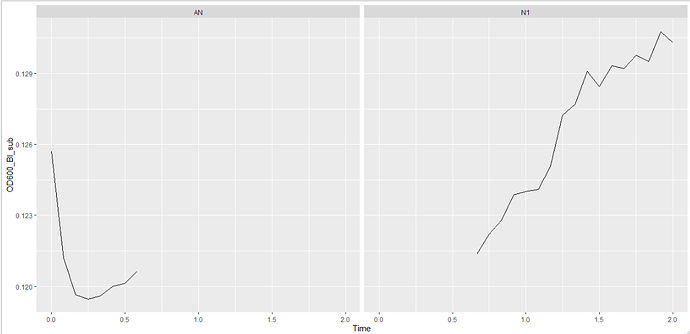Hi there,
I am trying to plot the growth curves of different bacterial lines and create a separate plot for each line. I couldn't figure out how I would design the for loop to iterate through the different levels of the variable "line" in the dataframe Growthdata. I tried it with something like that:
for (i in levels(Growthdata$line)){
split = Growthdata[Growthdata$line == i,]
ggplot(data=split, aes(x=Time, y= OD600_Bl_sub))+
geom_point(aes(color=rep))+
labs(color='Replicate')+
ggtitle(paset0("Line N", i))
ggsave(paste0("Line H", i, ".tiff"))
}
But it seems like the looping variable cannot be used like that (within squared brackets) in R.
I can give you a glimpse on the dataframe of the Growthdata:
structure(list(Time = c(0, 0.0833333333333333, 0.166666666666667,
0.25, 0.333333333333333, 0.416666666666667, 0.5, 0.583333333333333,
0.666666666666667, 0.75, 0.833333333333333, 0.916694444444444,
1, 1.08333333333333, 1.16669444444444, 1.25002777777778, 1.33336111111111,
1.41669444444444, 1.50002777777778, 1.58336111111111, 1.66669444444444,
1.75002777777778, 1.83336111111111, 1.91669444444444, 2.00002777777778
), Trt = c("PR_15_RG_N1_wiprey_hi_1", "PR_15_RG_N1_wiprey_hi_1",
"PR_15_RG_N1_wiprey_hi_1", "PR_15_RG_N1_wiprey_hi_1", "PR_15_RG_N1_wiprey_hi_1",
"PR_15_RG_N1_wiprey_hi_1", "PR_15_RG_N1_wiprey_hi_1", "PR_15_RG_N1_wiprey_hi_1",
"PR_15_RG_N1_wiprey_hi_1", "PR_15_RG_N1_wiprey_hi_1", "PR_15_RG_N1_wiprey_hi_1",
"PR_15_RG_N1_wiprey_hi_1", "PR_15_RG_N1_wiprey_hi_1", "PR_15_RG_N1_wiprey_hi_1",
"PR_15_RG_N1_wiprey_hi_1", "PR_15_RG_N1_wiprey_hi_1", "PR_15_RG_N1_wiprey_hi_1",
"PR_15_RG_N1_wiprey_hi_1", "PR_15_RG_N1_wiprey_hi_1", "PR_15_RG_N1_wiprey_hi_1",
"PR_15_RG_N1_wiprey_hi_1", "PR_15_RG_N1_wiprey_hi_1", "PR_15_RG_N1_wiprey_hi_1",
"PR_15_RG_N1_wiprey_hi_1", "PR_15_RG_N1_wiprey_hi_1"), OD600 = c(0.208100005984306,
0.203700006008148, 0.202199995517731, 0.202099993824959, 0.202299997210503,
0.20270000398159, 0.202800005674362, 0.203400000929832, 0.203999996185303,
0.204999998211861, 0.205599993467331, 0.206699997186661, 0.206799998879433,
0.206900000572205, 0.207800000905991, 0.209999993443489, 0.210600003600121,
0.211899995803833, 0.211300000548363, 0.212200000882149, 0.211999997496605,
0.212599992752075, 0.212400004267693, 0.213599994778633, 0.213100001215935
), OD600_Bl_sub = c(0.125700004398822, 0.121200005213419, 0.119633329411348,
0.119466662406922, 0.119599997997284, 0.120000004768371, 0.120133340358734,
0.120633333921432, 0.121366662283739, 0.12219999730587, 0.12279999256134,
0.123866664866607, 0.123999997973442, 0.124099999666214, 0.125066667795182,
0.127233328918616, 0.127700003484885, 0.129099994897842, 0.128433331847191,
0.129333334664504, 0.129199996590614, 0.129766657948494, 0.129500004152457,
0.130766659975052, 0.130300000309944), cycle = c("15", "15",
"15", "15", "15", "15", "15", "15", "15", "15", "15", "15", "15",
"15", "15", "15", "15", "15", "15", "15", "15", "15", "15", "15",
"15"), phase = c("RG", "RG", "RG", "RG", "RG", "RG", "RG", "RG",
"RG", "RG", "RG", "RG", "RG", "RG", "RG", "RG", "RG", "RG", "RG",
"RG", "RG", "RG", "RG", "RG", "RG"), line = structure(c(2L, 2L,
2L, 2L, 2L, 2L, 2L, 2L, 2L, 2L, 2L, 2L, 2L, 2L, 2L, 2L, 2L, 2L,
2L, 2L, 2L, 2L, 2L, 2L, 2L), .Label = c("AN", "N1", "N2", "N3",
"N4", "N5", "N6", "N7", "N8"), class = "factor"), prey = c("wiprey",
"wiprey", "wiprey", "wiprey", "wiprey", "wiprey", "wiprey", "wiprey",
"wiprey", "wiprey", "wiprey", "wiprey", "wiprey", "wiprey", "wiprey",
"wiprey", "wiprey", "wiprey", "wiprey", "wiprey", "wiprey", "wiprey",
"wiprey", "wiprey", "wiprey"), pred = c("hi", "hi", "hi", "hi",
"hi", "hi", "hi", "hi", "hi", "hi", "hi", "hi", "hi", "hi", "hi",
"hi", "hi", "hi", "hi", "hi", "hi", "hi", "hi", "hi", "hi"),
rep = c("1", "1", "1", "1", "1", "1", "1", "1", "1", "1",
"1", "1", "1", "1", "1", "1", "1", "1", "1", "1", "1", "1",
"1", "1", "1")), row.names = c(NA, 25L), class = "data.frame")
